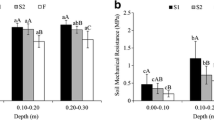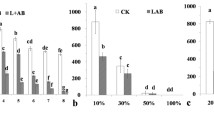Abstract
Nematode numbers were assessed at 2-week intervals in a coastal savanna soil amended with neem leaves and animal manure for 12 weeks under fallow conditions. The number of plant-parasitic nematodes decreased significantly with the application of the neem-based amendments, whereas the number of non-parasitic nematodes increased.
Similar content being viewed by others
References
Akhtar, M. (1999) Plant growth and nematode dynamics in response to soil amendments with neem products, urea and compost.Bioresour. Technol. 69:181–183.
Akhtar, M. and Malik, A. (2000) Roles of organic soil amendments and soil organisms in the biological control of plant parasitic nematodes. A review.Bioresour. Technol. 74:35–47.
Dropkin, V.H. (1989) Introduction to Plant Nematology. John Wiley and Sons, Inc., New York, NY.
Freed, R.D. (1992) How to Use MSTAT-C to Analyze On-Farm Experiments. Farming Systems Conference. Michigan State University, East Lansing, MI, USA.
Johnston, S.A., Probasco, P.R. and Phillips, J.R. (1994) Evaluation of soil fumigants and nematicides for the control of root-knot nematodes on carrot, 1993.Fungicide and Nematicide Tests 49:178.
Khan, F.A. (1994) Effect of soil amendments on the development ofPratylenchus brachyurus and growth and yield of okra.Afro-Asian J. Nematol. 4:84–87.
McSorley, R. and Frederick, J.J. (1999) Nematode population fluctuations during decomposition of specific organic amendments.J. Nematol. 31:37–44.
Neem Foundation (1997) Neem for fertilizer management. http://www.neemfoundation.org/fert.htm
Powers, L.E., McSorley, R. and Dunn, R.A. (1993) Effects of mixed cropping on a soil nematode community in Honduras.J. Nematol. 25:666–673.
Riegel, C., Fernandez, F.A. and Noe, J.P. (1996)Meloidogyne incognita infested soil amended with chicken litter.J. Nematol. 28:369–378.
Weibelzahl-Fulton, E., Dickson, D.W. and Whitty, E.B. (1996) Suppression ofMeloidogyne incognita andMeloidogyne javanica byPasteuria penetrans in field soil.J. Nematol. 28:43–49.
W.H.O. (1990) Global Estimates for Health Situation Assessment and Projections. Division of Epidemiological Surveillance and Health Situation and Trend Assessment, Geneva, Switzerland.
Author information
Authors and Affiliations
Corresponding author
Additional information
http://www.phytoparasitica.org posting July 14, 2005.
Rights and permissions
About this article
Cite this article
Agyarko, K., Kwakye, P.K., Bonsu, M. et al. Note: Effect of neem and organic amendments on nematode populations in a coastal savanna tropical soil. Phytoparasitica 33, 343–346 (2005). https://doi.org/10.1007/BF02981300
Received:
Accepted:
Issue Date:
DOI: https://doi.org/10.1007/BF02981300




